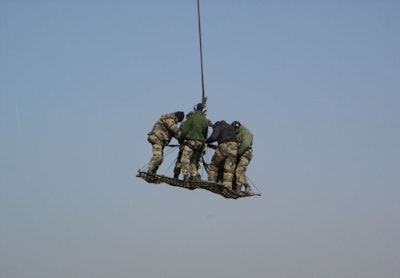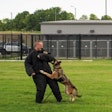 Photo courtesy of Escape International
Photo courtesy of Escape International
Getting people in and out of dangerous environments poses a challenge to law enforcement agencies on a regular basis. Fast roping is often an efficient way to deploy officers, but it has its limits as a tactic for SWAT and search-and-rescue missions—and it's not a way to rescue the wounded. Enter Escape International's AirTEP.
It may look like a trampoline or cargo net secured to a pole, but it's a platform that can either deploy or evacuate 10 people at once via helicopter, even if the people are wounded or otherwise incapacitated. This device has broad applications for law enforcement as well as other areas of public safety.
Members of the French anti-terrorist group Groupe d’Internvention de la Gendarmerie Nationale originally designed the AirTEP more than a decade ago as a means of quickly evacuating hostages or injured victims. Now it's been used for troop deployment and other functions in more than 20 countries, including the United States.
"AirTEP is not limited to armed striking forces any longer: medics surveying stretchers can fly it too, along with K-9 handlers and their dogs," says Yves de France, CEO of Escape International. "Many federal and state law enforcement agencies also use it as a life-saving device either in cities for very high building evacuation or in a deep forest environment," he adds. "For example, two years ago a young boy was rescued from a dangerous situation in the mountains near Seattle with the support of an AirTEP."
The AirTEP platform consists of a net of aramid fabric straps strung between five "umbrella" arms made of a special aluminum alloy that is strong yet flexible enough to allow them to bend and not break under the strain of a heavy load. "Above the whole reversed umbrella, a thick 75-foot-long rope binds the system to the helicopter cargo hook," de France says.
An on-board operator controls the platform's descent and opening, which takes about five seconds, with the option of automatic or manual unfolding. It can be operated from the central trap door of the helicopter or from the side door using a winch. According to the company, it takes a total of one minute to evacuate 10 people—including drop time, securing passengers, and take-off.
For American police departments this device that de France describes as an upside down umbrella is also a better solution for deploying officers than fast roping "when helicopter landing is not possible because of extended exposure or terrain issues and the hoisting system is inadequate because it would be too slow and risky," he says.
Some agencies opt to keep an AirTEP out in the field for faster deployment. This is possible because although it can carry a load of up to 3,300 pounds, it weighs only 115 pounds itself and fits in a cylinder measuring 5 feet by 2 feet. "The AirTEP can be rigged on the top of buildings or even aboard waterborne vessels," says de France.
These properties also mean having the platform on board won't affect a helicopter's speed or ease of movement during a mission, however it's being used. In fact, even when the AirTEP is deployed and hanging from a helicopter carrying a full load of passengers, it's possible to fly the craft at up to 100 knots for several miles until everyone can be brought to safety.
Multiple design features make this possible. This includes a safety strapping system, which de France says are so simple that it only takes two seconds to securely attach a person (or a dog) to the platform. "There are some clever parts in the AirTEP to include a removable braking system mounted on the rope in order to let operators slow the umbrella descent," says de France. "There is also a locking /unlocking system, which opens the umbrella at will during the descent. The arms are automatically locked in the open position when deployed."
De France is understandably proud of the AirTEP's ruggedness and reliability that makes it so capable as a deployment and rescue tool. "The AirTEP does not rotate on itself, even while flying at 100 knots," he says. "And yes, it does float."
Escape International's AirTEP platform is distributed and manufactured in the United States under Escape International’s license by Aerial Machine and Tool Corp.


















